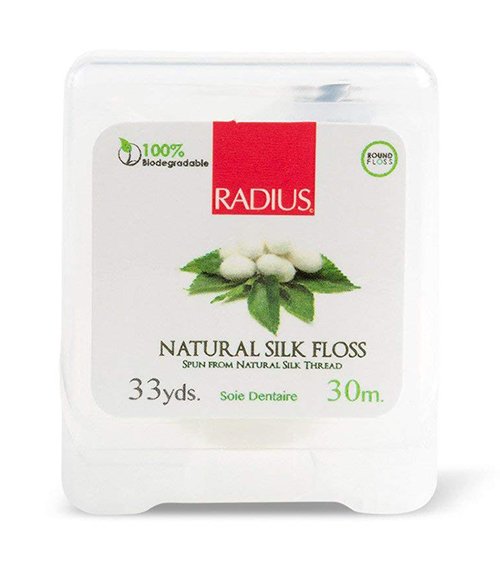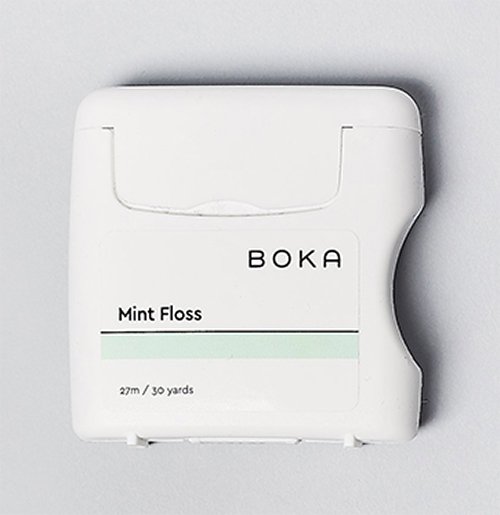Is Your Floss Toxic? How to Find and Use Safe Dental Floss
Disclosure:
Ask the Dentist is supported by readers. If you use one of the links below and buy something, Ask the Dentist makes a little bit of money at no additional cost to you. I rigorously research, test, and use thousands of products every year, but recommend only a small fraction of these. I only promote products that I truly feel will be valuable to you in improving your oral health.
It might be a question you’ve never considered, but are you using safe dental floss?
Flossing your teeth is a key component to excellent dental health. But you may be surprised to know what some manufacturers use to make this important dental necessity more marketable.
Is dental floss toxic? Some types of floss are made with toxic chemicals like Teflon. I’m also concerned about the impact of nylon on the environment, though I don’t see it as a toxin in the same way as Teflon.
I want to tell you about the ways toxic floss is made and provide a few alternatives for safe dental floss for your entire family.
Let’s take a look.
Toxic Ingredients in Dental Floss
Teflon
Yes, you are reading that word right: Teflon.
One of the ingredients used to make waxed floss is the same chemical group as the coating on many brands of non-stick pans.
Granted, you aren’t likely to swallow floss or ingest large amounts of Polytetrafluoroethylene (PTFE). But PTFE and PFOA (a related chemical) have been linked to adverse health conditions such as thyroid disease.
This is important because the most dangerous ways you may be exposed to Teflon are food and floss. Even tiny particles making it into your system are likely to cause serious issues.
Teflon exposure has been linked to:
Hormone imbalance
Cancer (1)
Autoimmune disease (2)
Neurotoxicity and Alzheimer’s disease (3, 4)
Before you feel overwhelmed by this information, let me encourage you: there are some quality alternatives to the popular brands we are used to seeing. I will recommend some of my favorites later in this post.
One of my personal favorites used to be Glide Pro-Health floss by Oral B. Once I discovered it was coated with Teflon, though, I quickly began looking for a healthier option.
See my top 3 options in the “Safe Dental Floss to Try” section below.
Nylon
Most floss is made from nylon.
Dictionary.com defines Nylon as: “A tough, lightweight, elastic synthetic polymer with a protein-like chemical structure, able to be produced as filaments, sheets, or molded objects.”
Little pieces of nylon can break off from your floss. The question is: where does it go? Do you swallow it?
It’s not something the body can break down any more than nylon products can break down in a garbage dump.
I don’t want that in my body—it reminds me of those toxic, plastic rings they find in the ocean. Where is it going? We aren’t sure. And we don’t know what’s happening to it later on.
While where it goes in my body is important, I’m even more concerned about the way nylon impacts the environment.
Nylon is not biodegradable. We have no way of knowing the impact of this substance sitting out in dumps and landfills.
Plus, the production of nylon creates chemicals that can pollute both the air and water. (5)
However, if it’s between nylon and Teflon…I recommend nylon every time. In fact, some of the flosses I recommend contain nylon.
I want to be clear here: Nylon is not toxic in the same way Teflon is toxic to your body. I’m more uncomfortable with a) what we don’t know about nylon yet and b) the way its production hurts the environment.
Do I really need to floss?
This is easiest question I’ve ever answered! YES, flossing is absolutely essential to good oral and dental health.
Many people have argued that, although they don’t floss, they regularly brush. They have a pain-free mouth, and never see food between their teeth.
While that may seem proof-positive that flossing isn’t necessary, seeing isn’t always believing. Bacteria can be microscopic and invisible to the eye. Even if your teeth are not tightly spaced, food particles can be trapped, creating a home in which plaque and tartar happily reside.
And while it may not cause physical pain, it will seriously affect your teeth over time. In addition to that, what’s in your mouth is swallowed into your body. This bacteria has been the cause of serious health issues.
In the article, Why Shouldn’t We Ignore the Oral Microbiome, I address the vital connection between the oral and intestinal microbiome.
Most dentists overlook the importance of this connection. But it’s simply too important to overlook, and forming proper, simple dental habits are the first key to achieving overall body health.
So, which is more important: brushing or flossing? Actually, I’d say it’s flossing!
I know that’s surprising for many people to hear. But, especially if you follow a mostly Paleo or keto type diet with limited starchy carbs, brushing is probably not as vital as you think.
Don’t get me wrong, though. I’m definitely not advocating you stop brushing your teeth.
Safe Dental Floss to Try
Is there a best safe dental floss? Here are some best dental floss options I’ve found.
Because I prefer unwaxed floss in my own daily routine, this is my number one pick. It’s 100% biodegradable since it’s made from silk rather than nylon.
Teflon and petroleum-free, this nylon floss is waxed with natural beeswax. It comes in a pleasant mint flavor, and is relatively inexpensive ($4-$5 for 30 yards). Good for your teeth, good for your checkbook.
Coconut-oil infused luxury, designed by a dentist, vegan and cruelty-free, and gluten free. What’s not to like? This wonderfully healthy product is just a little over $7 for a 32 yard spool.
Just as a note:
This one is the most expensive of the 3 products I’m sharing in this article. But, it is definitely the most effective product. At around $22, if you can swing it, you won’t be disappointed with the result.
Plus, it uses no traditional floss whatsoever, which means you get safe dental floss with no health or environmental drawbacks.
Frequently Asked Questions about Safe Dental Floss
Should I use waxed or unwaxed dental floss?
At the end of the day, the straight answer is, it doesn’t matter. What does matter is that consistent, frequent flossing takes place.
Some pros of waxed floss:
- Most comfortable (for many users)
- Different flavors enhance the flossing experience
- Many people experience less bleeding than when using unwaxed
Some pros of unwaxed floss:
- Thinner than waxed, easier to get between tightly spaced teeth
- Different flavors irritate some pregnant women, folks with sensitive tummies
- Price of product is less than waxed, and thus, preferable
To answer the frequently asked question: Which is best—waxed or unwaxed floss?
That’s easy! The best floss, the most safe dental floss for you is the one you use, because flossing is that important.
Is it okay to reuse floss?
No. The bacteria, food and other residue removed by flossing will remain on the floss product, no matter how you might try to clean it.
Even my “best floss” recommendations above are not so expensive that you would need to use the same piece a second time, and risk your health in the process.
What are the different types of floss?
Most of the time, floss is made of:
- Teflon
- Nylon
- Silk
- Polyester
Then, waxed floss is coated with a variety of waxes, like:
- Petroleum
- Beeswax
- Coconut oil
You can get floss in large spools or floss picks (with a small bit of floss in an access handle to make it easier to reach back teeth). Water flossers are a great option for people who want to have a more dentist’s office-type of experience with flossing.
Let’s recap.
Some common dental floss brands use toxic, harmful chemicals and substances.
The chemicals in Teflon may pass to your bloodstream through the sensitive blood vessels in the mouth. PTFE and PFOA have some incredibly dangerous impacts on human health, so I recommend avoiding Teflon floss altogether. (The most common Teflon floss is Glide Pro-Health floss.)
Nylon is not actually a toxic substance like Teflon. However, nylon is not biodegradable (which is concerning to me if it’s able to accumulate in the body). This fact, coupled with the manufacturing process creating harmful chemicals that pollute the air and water, makes it clear that nylon is a poor environmental choice.
Sure, it’s safe to assume most people don’t swallow their floss. But the way floss is supposed to be used makes it impossible to keep these chemicals from coming off the floss and out into your mouth.
Here’s the great news—you’ve got healthy options to choose from!
Maybe you’ll choose beeswax or coconut oil as an alternative to chemical coating of floss. Maybe you will choose unwaxed floss.
But what’s most important is the choice to floss!
If you have any additional questions about flossing, just ask me and I’ll respond personally.
read next: Hospitals Are Fighting Pneumonia With Brushing and Flossing (And Winning)References
- Environmental Working Group, (2007). EWG assessment of EPA draft human health risk assessment for the teflon chemical PFOA. Retrieved from: https://www.ewg.org/research/ewg-assessment-epa-draft-human-health-risk-assessment-teflon-chemical-pfoa#.WkVkolQ-eCQ
- Steenland, K., Zhao, L., Winquist, A., & Parks, C. (2013). Ulcerative colitis and perfluorooctanoic acid (PFOA) in a highly exposed population of community residents and workers in the mid-Ohio valley. Environmental health perspectives, 121(8), 900. Full text: https://www.ncbi.nlm.nih.gov/pmc/articles/PMC3734500/
- Shaw, C. A., & Tomljenovic, L. (2013). Aluminum in the central nervous system (CNS): toxicity in humans and animals, vaccine adjuvants, and autoimmunity. Immunologic research, 56(2-3), 304-316. Abstract: https://www.ncbi.nlm.nih.gov/pubmed/23609067
- Mirza, A., King, A., Troakes, C., & Exley, C. (2017). Aluminium in brain tissue in familial Alzheimer’s disease. Journal of Trace Elements in Medicine and Biology, 40, 30-36. Full text: https://www.sciencedirect.com/science/article/pii/S0946672X16303777?via%3Dihub
- Chen, H. L., & Burns, L. D. (2006). Environmental analysis of textile products. Clothing and Textiles Research Journal, 24(3), 248-261. Full text: https://www.researchgate.net/profile/Leslie_Burns/publication/247782661_Environmental_Analysis_of_Textile_Products/links/56606e5e08ae4931cd5978e2/Environmental-Analysis-of-Textile-Products.pdf
The post Is Your Floss Toxic? How to Find and Use Safe Dental Floss appeared first on Ask the Dentist.
from Ask the Dentist https://askthedentist.com/safe-dental-floss/





Comments
Post a Comment